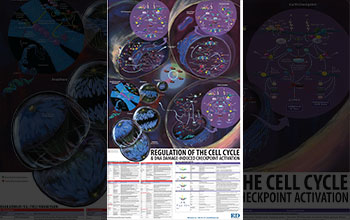Multimedia Gallery
"Regulation of the Cell Cycle and DNA Damage-Induced Checkpoint Activation"
"Regulation of the Cell Cycle and DNA Damage-Induced Checkpoint Activation," by Erin Olson and her team at R&D Systems Inc., Minneapolis, Minn.
Inside a cell's nucleus, some proteins act like quality control auditors, ensuring that it's safe for the cell to copy its DNA and divide. This informational graphic from Erin Olson and her team at R&D Systems Inc. sketches how these proteins seek out DNA damage during checkpoints as the cell moves between the four stages of its cycle. In the purple circles, they juxtapose the actions of the checkpoint proteins with the normal events inside the cell's nucleus. Some of these checkpoint proteins detect DNA damage, while others sit on the broken site and recruit new proteins to send out the call for DNA repair enzymes to fix the problem. Olson hopes the poster will serve as a quick reference for researchers and biology students.
This image won Honorable Mention in the Informational Graphics category of the 2009 International Science & Engineering Visualization Challenge (SciVis) competition, sponsored by the National Science Foundation and the journal Science. The competition is held each year to celebrate the grand tradition of science visualization and to encourage its continued growth. The spirit of the competition is to communicate science, engineering and technology for education and journalistic purposes. To learn more about the competition and view all the winning entries, see the NSF SciVis Special Report. (Date of Image: January-April 2009)
Credit: Erin Olson, Daphne Orlando and Tim Manning; R&D Systems Inc.
Images and other media in the National Science Foundation Multimedia Gallery are available for use in print and electronic material by NSF employees, members of the media, university staff, teachers and the general public. All media in the gallery are intended for personal, educational and nonprofit/non-commercial use only.
Images credited to the National Science Foundation, a federal agency, are in the public domain. The images were created by employees of the United States Government as part of their official duties or prepared by contractors as "works for hire" for NSF. You may freely use NSF-credited images and, at your discretion, credit NSF with a "Courtesy: National Science Foundation" notation.
Additional information about general usage can be found in Conditions.
Also Available:
Download the high-resolution JPG version of the image. (2.8 MB)
Use your mouse to right-click (Mac users may need to Ctrl-click) the link above and choose the option that will save the file or target to your computer.

